九年级下册 unit 5教案2
人教版九年级英语全一册Unit5第2课时教案
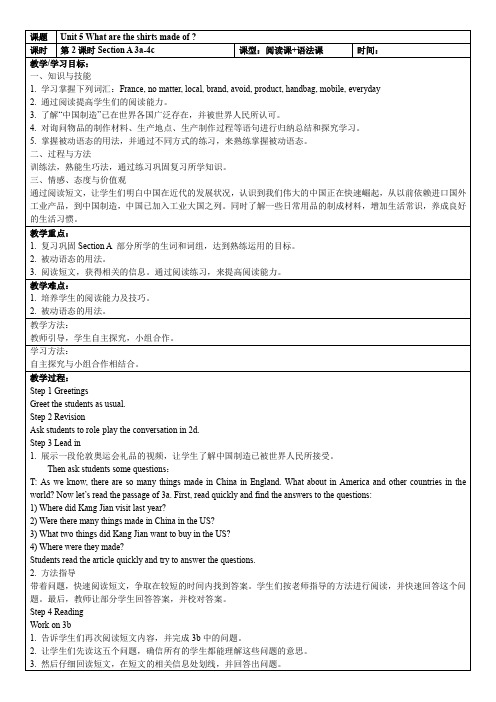
Read the second paragraph and fill in the blanks.
Toys are not the only things made in China. ______, there were many other things made in China--footballs, handbags, pet food, mobile phones. Even ______________ are made in China. He ________that Americans could_______ ______ ______ products made in China.
9.在杭州人们种植茶叶。
People_______ ________ in Hang Zhou.
Tea _____ ________ (by people) in Hang Zhou.
Step 8 Summary
1.被动语态
当主语为动作的执行者时,谓语的形式为主动语态;当主语为动作的承受者时,谓语要用被动语态。
课题
Unit 5 What are the shirts made of?
人教九年级英语unit5教案

人教九年级英语unit5教案一、教学目标。
1. 语言知识目标。
- 学生能够正确使用下列重点单词和短语:be made of, be made from, be made in, be made by, chopsticks, coin, fork, blouse, silver, glass, cotton,steel等。
- 掌握一般现在时的被动语态的结构(am/is/are + 过去分词)及其用法。
2. 语言技能目标。
- 听:能听懂有关物品的制作材料、产地等方面的简单对话。
- 说:能够用英语询问和描述物品是由什么制成的、在哪里制造的等。
- 读:能读懂介绍产品制造相关信息的文章。
- 写:能够根据提示写出含有被动语态的句子,描述物品的制作情况。
3. 情感态度目标。
- 了解不同国家的特色产品及其制作工艺,增强文化意识。
- 培养学生的环保意识,意识到资源回收利用的重要性。
二、教学重难点。
1. 教学重点。
- 掌握一般现在时的被动语态的用法。
- 学会运用be made of, be made from, be made in, be made by等短语描述物品的相关信息。
2. 教学难点。
- 区分be made of和be made from的用法差异。
- 正确运用一般现在时的被动语态进行书面表达。
三、教学方法。
1. 情景教学法。
通过创设各种与物品制作相关的情景,让学生在真实的语境中学习和运用英语。
2. 任务驱动法。
布置各种任务,如小组讨论、角色扮演、调查等,让学生在完成任务的过程中提高语言综合运用能力。
3. 直观教学法。
运用图片、实物等直观教具,帮助学生更好地理解和记忆单词和短语。
四、教学过程。
(一)导入(5分钟)1. 展示一些常见物品的图片,如筷子、硬币、衬衫等,问学生:“What can you see in the pictures?”引导学生说出这些物品的英文名称。
2. 然后拿出一个用竹子做的筷子和一个用金属做的硬币,问学生:“What are they made of?”引出本节课的重点短语be made of。
2020年人教版英语九年级 Unit5 全单元教案设计
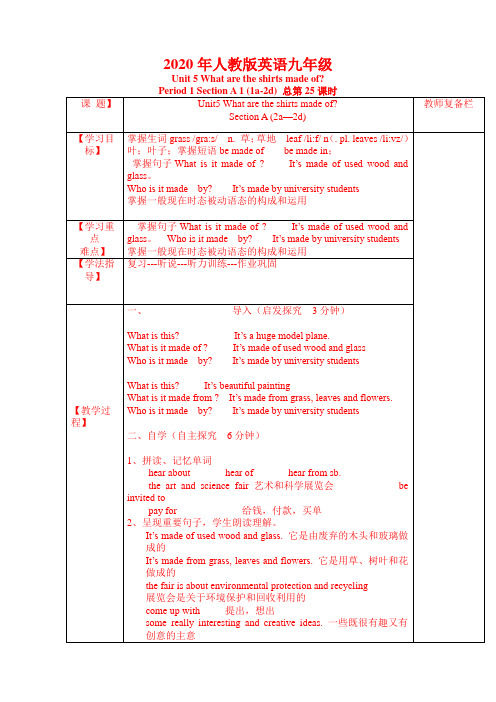
2020年人教版英语九年级Unit 5 What are the shirts made of?Period 2 Section A Section A (3a-3c) 总第26课时一、教学目标:1. 语言知识目标:1) 学习掌握下列词汇:France, no matter, local, brand, avoid, product, handbag,mobile, everyday2)阅读短文,能按要求找到相应的信息。
3)通过阅读提高学生们的阅读能力。
4) 了解“中国制造”已在世界各国广泛存在,并被世界人民所认可。
2. 情感态度价值观目标:通过阅读短文,让学生们明白中国在近代的发展状况,认识到我们伟大的中国正在快速崛起,从以前依赖进口国外工业产品,到中国制造,中国已加入工业大国之列。
二、教学重难点1. 教学重点:1) 掌握本部分出现的生词和词组,达到熟练运用的目标。
2) 阅读短文,获得相关的信息。
通过阅读练习,来提高阅读能力。
2. 教学难点:1) 阅读短文,获得相关的信息的能力。
2) 理解并运用所学的词汇及表达方式。
三、教学过程Ⅰ. Revision1. Ask Ss to role-play the conversation in 2d.2. Check the homework. Let some Ss tell read their sentences.(1). This ring is made of silver.(2). This kind of paper is made from wood.(3). What is paint made from?(4). Hang Zhou is famous for tea.(5). As far as I know, tea plants are grown on the sides of the mountains.Ⅱ. Lead in1. 展示一段伦敦奥运会礼品的视频,让学生了解中国制造已被世界人民所接受。
人教新目标英语九年级Unit5全单元教案

人教新目标英语九年级Unit 5 What are the shirts made of?Section A 1 (1a-2d)一、教学目标:1. 语言知识目标:1) 能掌握以下单词:chopsticks, coin, fork, blouse, silver, glass, cotton, steel, grass,leaf, produce, widely, be known for, process, pack 能掌握以下句型:①—This ring looks nice. Is it made of silver?—Yes, and it was made in Thailand.②What is it made of/from?③China is famous for tea, right?④Where is tea produced in China?2) 能够用英语描述及询问物品的制作材料,正确理解被动语态的用法及句子结构。
2. 情感态度价值观目标:了解一些日常用品的制成材料,增加生活常识,养成良好的生活习惯;了解一些地方知名产品或传统艺术品的制作过程以及制作材料,培养学生的民族自豪感及爱国主义精神。
二、教学重难点1. 教学重点:1) 掌握本课时中出现的生词2) 能够用英语描述及询问物品的制作材料3)正确理解被动语态的用法及句子结构。
2. 教学难点:理解被动语态的用法及句子结构。
三、教学过程Ⅰ. Warming up1. Present the sentence structure, using the pictures on the big screen:—What’s the golden medal made of?—It’s made of gold.—Is this table made of wood?—No, it isn’t. It’s made of glass.—Is Butter made from meat?—No. It’s made from milk.II. Presentation1. Show some pictures on the big screen. Try to learn the new words using “be made of”structure.Learn the new words: chopsticks, coin, fork, blouse, silver, glass, cotton, steel, grass, leaf2. Ss discuss with their partner and try to learn the new words.3. Give Ss five more minutes to remember the new words.4. Work on 1a:Let Ss read the things and materials in 1a. Discuss with their partners and match them with the materials. More than one answer is possible.What are these things usually made of? Match them with the materials. More than one answer is possible.Check the answers with the Ss.III. Listening1.T: Tell Ss they will hear a conversation about some things and material. Listen andmatch the products with what they are made of and where they were made.2. Let one student read the words in the box, Play the recording for the Ss to listen.3. Ss try to listen and match the things with the material and here they were made.4. Play the recording again. Let Ss answer the questions.1) How much did Susan pay for the three shirts?29 dollars.2) What does Anita feel about the three shirts?Cheap.3) What are the shirts made of?Cotton.4) Where were they made?America.5) Where did Susan buy the chopsticks?Korea.6) How does Anita like the chopsticks?Cool.7) What else does Susan show?Ring.8) Where was the ring made?Thailand.9) What will Susan do with the ring?She give it to her friend.IV. Pair work1. Read the conversation in the box in 1c.2. Ss try to made conversations using the information in 1b.e.g. A: Your new shirt looks very nice. Is it made of cotton?B: No, it isn’t. It’s made of silk.3. Let some pairs read out their conversations.V. ListeningPre-listeningfair adj. 公平的; 合理的; 美丽的fair n. an event at which people orbusinesses show and sell productsa book faira trade fairWork on 2a:T: Let’s listen to another conversation between Nick and Marcus.1. What are they talking about? First, let’s look at the pictures and the phrases in 1a.(Let one students read the phrases in 2a.)Listen and check ( √) the main topic of Nick and Marcus’ conversation.____ the science museum____ the art and science fair____ environmental protection____ a model plane____ a beautiful painting____ grass and leaves2. Play the recording for the Ss to listen and check the phrases.3. Play the recording again to check the answers.Work on 2b:1. Let Ss read the sentences below. Explain some main sentences for the Ss. Make sure they know what to do.2. Let Ss read the questions in 2b. Make sure they understand the meaning of each question.Play the recording for the Ss to answer the questions. (If necessary, using the pause button.)1) Where is the art and science fair?_________________________2) Do Nick and Marcus have to pay to go?_________________________3) What is the model plane made of?_________________________4) What is the painting made from?__________________________3. Play the recording again and mark true or false.1) The art and science fair is just inside the science museum.2) The fair is mainly about planes and paintings.3) All the works at the fair were made by university students.4) The model plane is very big.5) The painting is made of wool and grass.6) The students are asked to pay for the art and science fair.7) The students are interested in environmental protection and recycling.VI. Pair work1. Tell Ss to make a conversation using the information in 2a and 2b.e.g.A: What did you see at the art and science fair?B: I saw a model plane.A: What is it made of?B: It’s made of steel, glass, and plastic.2. Let Ss make their own conversations.3. Practice their conversations in pairs.VII. Role-play1. Work on 2dRead the conversation and complete the blanks.1) Chinese _____________ tea both in the past and now.2) _________ I know, tea plants _________ on the sides of mountains.3) When the leaves are ready, they _______ by hand and then _______ for processing.4) The tea ____________ and sent to many different countries and places around China.5) People say that tea ___________ ____ health _____ business!2. Read the conversations and Let Ss read after the teacher.3. Ask Ss to role-play the conversation in groups.VIII. Language points1. What is the model plane made of?What is the painting made from?be made of与be made from 辨析两词组都是“由……制成的”之意。
2021-2022学年仁爱版英语九年级下册Unit 5

Section C教学设计I. 教学内容:本单元的主题是China and the world,以中西方文化为主要内容。
话题1 China attracts millions of tourists from all over the world以介绍中国文化为主线来介绍中国的风景名胜。
本节课的学习内容为 Section C,围绕文化主题,通过学习描述中国的万里长城---这一具有鲜明文化特色的中国古代建筑,激发学生使用英语介绍本国文化的兴趣,增强其对祖国文化的热爱,培养学生的民族自豪感和自信心。
II. 教学目标:1. 知识目标:词汇:正确识读与描述与中国名胜相关的词汇,熟练掌握以下重要表达方式:stretch from…to…, a treasure of Chinese civilization, remain, separate, enemy, expect等。
语法:理解定语从句的功能功能:使用口笔语的方式描述所熟悉的国内风景名胜,特别是古代建筑。
2. 能力目标:1)能借助图片和题目等预测信息,并结合已有常识听懂有关长城的英文介绍。
2)能通过浏览获取文章的大意,通过细读了解长城的历史:概况、修建的时间、材料和作用以及现代文化意义等。
3)能对获取的信息进行梳理和加工,分析课文结构,总结逻辑关系。
4)能使用较复杂的语言结构,如使用定语从句,描述中国的风景名胜。
3. 情感态度:通过学习描述“the Great Wall”这一具有鲜明文化特色的中国古代建筑,激发学生使用英语介绍本国文化的兴趣,增强其对祖国文化的热爱,培养学生的民族自豪感和自信心。
III.教学难点:如何帮助学生在理解文本的前提下,以口头表达为基础,结合所学内容进行书面表达练习,让学生对本节课的词汇和语法等语言知识进行有意识的语言输出,提高其语言掌握的程度。
IV. 学习策略:掌握根据上下文语境猜测词义的阅读策略和用英语思考的意识,增强语感。
人教版新目标九年级英语Unit5单元集体备课教案
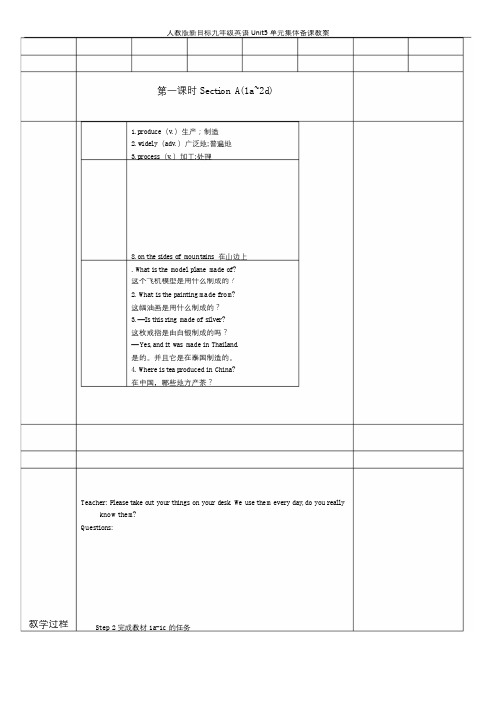
第一课时Sect i on A(1a~2d)1.produce(v.)生产;制造2.wide ly(adv.)广泛地;普遍地3.process(v.)加工;处理8.on the s ides o f mount a ins在山边上.What i s the model p lane made of?这个飞机模型是用什么制成的?2.What i s the pa in t ing made f rom?这幅油画是用什么制成的?3.—Is th i s r ing made of s i lver?这枚戒指是由白银制成的吗?—Yes,and i t was made in Tha i land.是的。
并且它是在泰国制造的。
4.Where i s t ea p roduced in China?在中国,哪些地方产茶?Teacher: P lease t ake out your th ings on your desk.We use them every day,do you rea l ly know them?Ques t ions:教学过程Step 2完成教材1a-1c的任务5.小结训练。
要求学生在规定的时间内完成一个小练习。
并请若干学生给出自己的答案。
有错误的话及时纠正。
(2分钟)用括号内所给动词的正确形式填空。
1)The apples a re sen t(send)to the fac tory f or p rocess ing.2)We are a l l r eady bu t Tom hasn’t packed (pack) h i s c lo thes ye t.3)The windows of the room are c leaned(c lean)every day.4)The bes t co t ton i s p r oduced(p roduce)in Xing J iang in China.5)The song isn’t liked (no t l ike) by mos t o f us.环节说明:通过学习1a,使学生对被动结构有所了解;通过1b,锻炼学生的听力及抓取关键信息的能力;通过1c的训练锻炼学生的口头表达能力,同时巩固对一般现在时被动结构的认识。
优品课件之九年级英语下册Module5 Unit2教案(外研版)
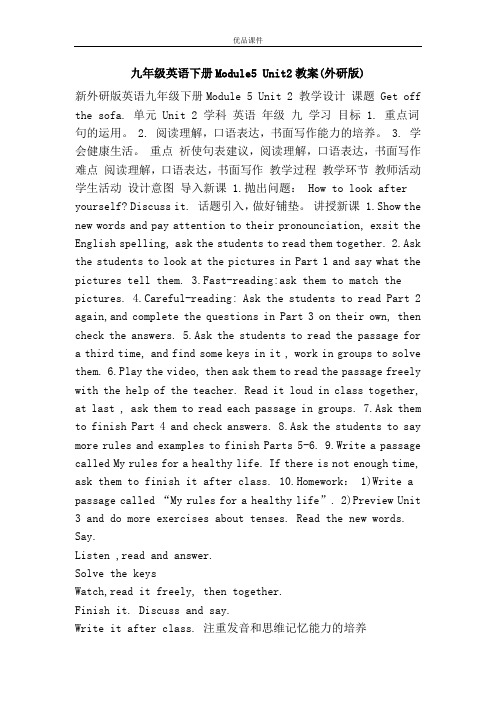
九年级英语下册Module5 Unit2教案(外研版)新外研版英语九年级下册Module 5 Unit 2 教学设计课题 Get off the sofa. 单元 Unit 2 学科英语年级九学习目标 1. 重点词句的运用。
2. 阅读理解,口语表达,书面写作能力的培养。
3. 学会健康生活。
重点祈使句表建议,阅读理解,口语表达,书面写作难点阅读理解,口语表达,书面写作教学过程教学环节教师活动学生活动设计意图导入新课 1.抛出问题: How to look after yourself? Discuss it. 话题引入,做好铺垫。
讲授新课 1.Show the new words and pay attention to their pronounciation, exsit the English spelling, ask the students to read them together. 2.Ask the students to look at the pictures in Part 1 and say what the pictures tell them. 3.Fast-reading:ask them to match the pictures. 4.Careful-reading: Ask the students to read Part 2 again,and complete the questions in Part 3 on their own, then check the answers. 5.Ask the students to read the passage for a third time, and find some keys in it , work in groups to solve them. 6.Play the video, then ask them to read the passage freely with the help of the teacher. Read it loud in class together, at last , ask them to read each passage in groups. 7.Ask them to finish Part 4 and check answers. 8.Ask the students to say more rules and examples to finish Parts 5-6. 9.Write a passage called My rules for a healthy life. If there is not enough time, ask them to finish it after class. 10.Homework: 1)Write a passage called “My rules for a healthy life”. 2)Preview Unit 3 and do more exercises about tenses. Read the new words. Say.Listen ,read and answer.Solve the keysWatch,read it freely, then together.Finish it. Discuss and say.Write it after class. 注重发音和思维记忆能力的培养培养口头表达能力。
九年级英语全册 Unit 5 (第2课时)教案

Unit 5 What are the shirts made of?(第2课时)一、教材分析:本节课的主要话题是谈论产品由什么制造及其产地,同时在文中巩固复习被动语态的构成及应用。
二、三维目标(一) 知识与技能1. To learn more about passive voice.2. To understand the pasage on Page35.(二) 过程和方法3. To get a general knowledge of the passage by reading and role-play.4. To know how to make sentences and express correctly using passive voice.(三) 情感态度和价值观5. After learning this part, every student will know more about products and learnto be cooperative in the course of learning.三、教学重点1. Further learning about passive voice.2. to understand the passage on Page 35.四、教学难点1. To know the sentence pattern: find it + 宾补 + that …2. to understand the passage on Page 35.五、教学策略根据本课教学目标和重点内容,教师可采用听,读,小组讨论,角色扮演等活动来引导学生进行学习。
六、教学准备ppt, recorder, mutiple-media七、教学环节1、课堂导入Step 1 Lead-inRole—play\Role—play the conversation on Page 34Pam: China is famous for tea, right?Liu Jun: Yes, both in the past and now.Pam: Where is tea produced in China?Liu Jun: Well, in amny different areas. For example, Anxi and Hangzhou are widely known for their tea.2. 课堂讲授Step 2. Reading1) Fast-readingNow turn to page 35 and read the page quickly to find answers to the questions.1.Where did Kang Jian go to visit his uncle and aunt?2.What did he discover in the toy stores?3.Why did he have to visit many stores before buying a pair ofbasketball shoes?4.What did he realize after his shopping experiences?Answers:1. He went to San Francisco.2. Most of the toys had American brands, but they were made in China.3. He want to find a pair of shoes made in America.4. He realized that Americans can hardly avoid buying products made in China.2) careful-readingRaed the passage again and write what the underlined word refer to.1. No matter what yoy may buy, you might properly think those products were madein those countries.those:_______________________those: ______________________2. He found it interesting that so many products in local shops were made of China. it: ____________________________3. I want to buy a toy car for my cousin, but even though most of the toys hadAmerican brands, they were made in China.they:_______________________Answers: 1. the products he saw in other countriesJapan, France, Switzerland…2. so many products in local shops were made of China3. most of the toys he saw in America3) Studying useful structures.1) He found it interesting that so many products in local shops were made of China.本句结构为:Find + it + 宾补+ that / to do…It在句中为形式宾语。
仁爱版九年级英语下册教学设计:Unit5Topic2SectionD

(二)教学设想
1.针对词汇和语法教学,采用以下策略:
(1)利用图片、实物等教学辅助手段,帮助学生形象地记忆和理解词汇。
(2)设计丰富多样的课堂活动,如单词接龙、填空、改错等,巩固学生对词汇和语法的掌握。
(3)通过例句和情境创设,引导学生学会在不同语境中运用所学知识。
3.引导学生通过自主、合作、探究的学习方式,培养他们的思维品质和解决问题的能力。
4.鼓励学生积极参与课堂活动,敢于开口表达,提高他们的自信心和合作意识。
5.注重分层教学,关注每个学生的学习进度,给予个性化指导,使他们在原有基础上得到提高。
(三)情感态度与价值观
在本章节的教学中,教师将关注学生的情感态度和价值观的培养:
5.通过小组讨论和分享,提高学生的英语听说能力,使他们能够流利地表达自己的观点和想法。
(二)过程与方法
在本章节的教学过程中,教师将采用以下方法和策略:
1.采用任务型教学法,设计丰富的课堂活动,如小组讨论、角色扮演、情景剧等,激发学生的学习兴趣,提高他们的英语实践能力。
2.利用多媒体教学资源,如图片、视频、音频等,创设生动、真实的语境,帮助学生更好地理解和运用所学知识。
2.学会使用一般现在时和一般过去时描述人物的特点和经历,运用情态动词can, may, must表达对人物能力的推测。
3.能够理解并运用一般将来时谈论未来的计划和目标,学会用so that, in order to等表达目的。
4.提高学生的英语阅读能力,培养他们快速捕捉文章主旨和大意的能力,掌握文章中的关键信息。
(2)组织角色扮演、小组讨论等活动,为学生提供更多口语实践机会。
九年级Unit5Whataretheshirtsmadeof课堂大比武被动语态微课教案
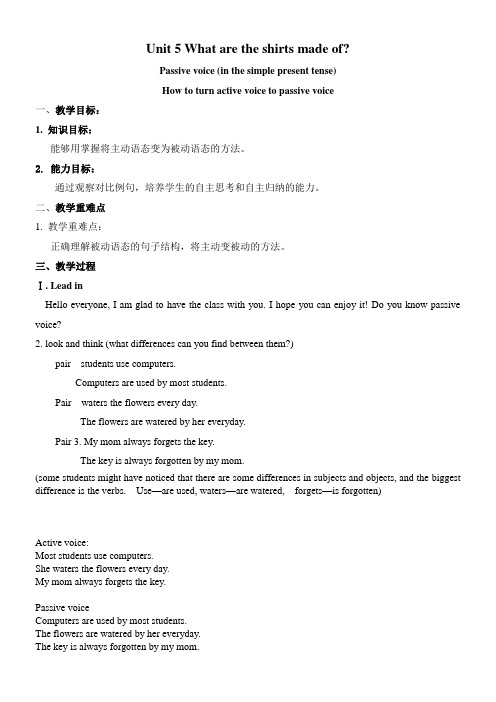
Unit 5 What are the shirts made of?Passive voice (in the simple present tense)How to turn active voice to passive voice一、教学目标:1. 知识目标:能够用掌握将主动语态变为被动语态的方法。
2. 能力目标:通过观察对比例句,培养学生的自主思考和自主归纳的能力。
二、教学重难点1. 教学重难点:正确理解被动语态的句子结构,将主动变被动的方法。
三、教学过程Ⅰ. Lead inHello everyone, I am glad to have the class with you. I hope you can enjoy it! Do you know passive voice?2. look and think (what differences can you find between them?)pair students use computers.Computers are used by most students.Pair waters the flowers every day.The flowers are watered by her everyday.Pair 3. My mom always forgets the key.The key is always forgotten by my mom.(some students might have noticed that there are some differences in subjects and objects, and the biggest difference is the verbs. Use—are used, waters—are watered, forgets—is forgotten)Active voice:Most students use computers.She waters the flowers every day.My mom always forgets the key.Passive voiceComputers are used by most students.The flowers are watered by her everyday.The key is always forgotten by my mom.4. observe and summaryLet’s observe them again and think carefully how to change the sentences in active voice into passive voice.Step 1: put the objects at the beginning of the sentence as the subjects.Step2: change the verbs into “ be(am/is/are+ past participle)”.Step 3: put the subjects at the end of the sentence after ”by”.5. exercise1.We speak Chinese.---- Chinese is spoken by us.2.They grow tea in Bazhong.---- Tea is grown by them in Bazhong.3. She cleans the rooms every day.---- The rooms are cleaned by her every day.1. The postman brings the letter to my friend.----The letter is brought to my friend by the postman.2. The shop uses the best materials to make dresses.----The best materials are used to make dresses by the shop.3. My parents take good care of me.Possible answer:I am taken good care by my parents.Correct answer:I am taken good care of by my parents.Pay attention to our mistakes, do not cut down any part of a phrase.and reviewhow to change the sentences in active voice into passive voice.Step 1: put the objects at the beginning of the sentence as the subjects.Step2: change the verbs into “ be(am/is/are+ past participle)”.Step 3: put the subjects at the end of the sentence after ”by”.Write down five sentences in active voice, and then turn them into passive voice.。
九年级英语全册 Unit 5A(2d)教案 (新版)人教新目标版.doc

看起来他在考试前一点都不紧张。
____ that he was not a bit nervous before the exams.
【解析】用“It seems that…”结构,再由was确定seem要用过去式。正确答案是It seemed。
3、For example,Anxi and Hangzhou are widely known for their tea.比如,安溪和杭州因茶叶而广为人知。
B: I argued with my parents.
A: I don’t think it’s polite.
B: I think so, but my parents didn’t allow me to throw some old things away.
A: What are they?
The area is famous as a green tea producing place.
当主语是事物名词时,be famous for表示“以其内容、特征、价值等而被人所知”;be famous as则表示“以某种形式出名”。
This grammar book is famous for its practical usage.
4. begin _____________ _____________
5. blow _____________ _____________
6.break _____________ _____________
7.bring _____________ _____________
8.bulid _____________ _____________
2.As far asI know , tea plantsare grownon the side of mountains.
九年级英语全册 Unit 5 What are the shirts made of Section B(2a-2e)教案 (新版)人教新目标版

3. Chinese clay
clay
Step 2.朗读
1、先邀请几位同学阅读短文(可一人一段),注意语音语调、句群停顿,及时纠正。
2、播放录音,全班同学一起跟读,尽力模仿语音语调、句群停顿。(3分钟)
Step 3理解课文,完成教材2c-2e的任务
1.让学生再细读短文,回答2c的所提出的问题。(5分钟)
3. The most common pictures of paper cuttings are flowers, animals and things abut Chinese history.
4. During the Spring Festival, they are put on windows, doors and walls as symbols of wishes for good luck and a happy new year.
2.起火;燃烧
Damp wood will not fire.潮湿的木头不会燃烧。
3.激动;突然发怒
He fired up at the remark.他一听这话突然发怒了。
【课堂变式】
1.The real golden _____________.(真金不怕火炼)。
【解析】不怕火炼就是不怕在高温下煅烧。要用fire作动词的被动形式。故答案为:isn’t afraid of being fired
1. They usually try to show the things that are importantin life, such as love, beauty and family.
2. The sky lanterns were used for asking for help when in trouble in the past and now they are used as bright symbols of happiness and good wishes.
外研版九年级英语下册教案 Module5 Unit2
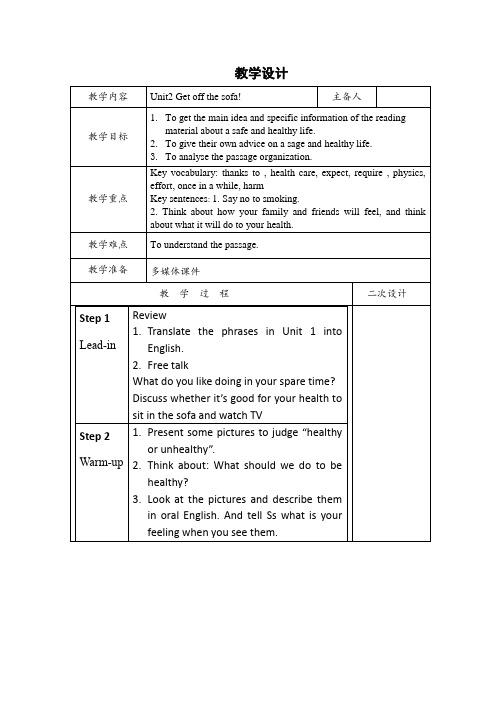
教学内容
Unit2 Get off the sofa!
主备人
教学目标
1.To get the main idea and specific information of the reading material about a safe and healthy life.
2.To give their own advice on a sage and healthy life.
2. Think about how your family and friends will feel, and think about what it will do to your health.
教学难点
To understand the passage.
教学准备
多媒体课件
教 学 过 程
二次设计
2.Prepare for Unit3.
教学反思
Step 2
Warm-up
1.Presentsome picturesto judge“healthy or unhealthy”.
2.Think about:What should we do to be healthy?
3.Look at the picturesanddescribe them in oral English. And tellSswhat is your feeling when you see them.
Step3
Read
1.Read the passage and match the rules with the pictures.
2.Read again and answer the questions.
仁爱版九年级英语下册第五单元topic2 sectionc教案
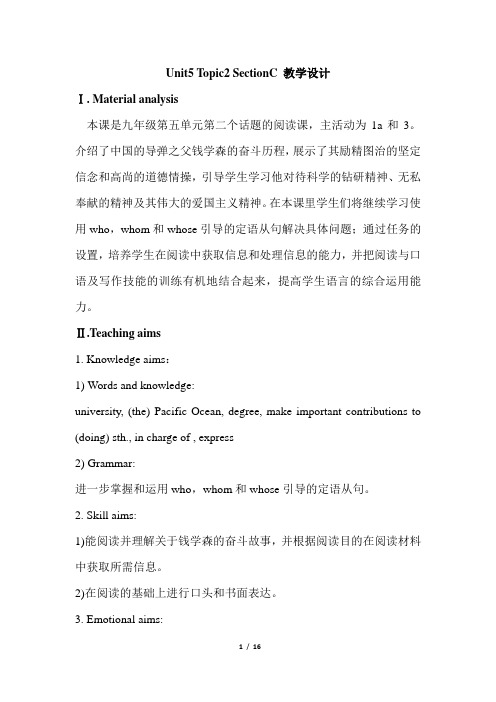
Unit5 Topic2 SectionC 教学设计Ⅰ. Material analysis本课是九年级第五单元第二个话题的阅读课,主活动为1a和3。
介绍了中国的导弹之父钱学森的奋斗历程,展示了其励精图治的坚定信念和高尚的道德情操,引导学生学习他对待科学的钻研精神、无私奉献的精神及其伟大的爱国主义精神。
在本课里学生们将继续学习使用who,whom和whose引导的定语从句解决具体问题;通过任务的设置,培养学生在阅读中获取信息和处理信息的能力,并把阅读与口语及写作技能的训练有机地结合起来,提高学生语言的综合运用能力。
Ⅱ.Teaching aims1. Knowledge aims:1) Words and knowledge:university, (the) Pacific Ocean, degree, make important contributions to (doing) sth., in charge of , express2) Grammar:进一步掌握和运用who,whom和whose引导的定语从句。
2. Skill aims:1)能阅读并理解关于钱学森的奋斗故事,并根据阅读目的在阅读材料中获取所需信息。
2)在阅读的基础上进行口头和书面表达。
3. Emotional aims:1)能积极与同伴合作参与课堂活动,大胆实践。
2)对著名的历史人物有更深刻的了解,能从小树立为人类的幸福而奋斗的远大理想。
4. Learning strategies1)根据需要进行预习。
(homework)2)在学习中积极思考,主动探究,善于发现语言的规律并能运用规律举一反三。
Ⅲ. The key points and difficult points1. Words and phrases:university, (the) Pacific Ocean, degree, make important contributions to (doing) sth., in charge of , express2. Sentences:1) After he graduated, he became a teacher as well as a researcher who studied rockets and missile theories.2) He is the pride of the Chinese people.3. Grammar:Attributive clauses (who/whom/whose)Ⅳ. Teaching aids多媒体课件,或袁隆平、钱学森及航天方面的图片,发射导弹的视频资料, 阅读理解语篇。
U5TomSawyerpaintsthefence教案2021-2022学年牛津上海版九年级英语下册

Unit Five Tom Sawyer paints the fence教材分析以及学情分析:本篇课文取自于马克吐温的著名小说《汤姆索亚历险记》,主课文部分节选了其中一段汤姆索亚利用了自己的智慧完成了非常苛刻的任务,读来充满了故事性,童趣和智慧,非常容易理解。
而作为初中科文中为数不多的名著简译本的节选,通过学习课文不但使学生掌握了文章中的语言知识点,也唤起了他们对名著阅读的兴趣。
听力部分配合课文简要介绍了马克吐温的生平,使学生在原来的基础上进一步提高了文学修养,也学会了在听力练习的过程中如何更好地抓住重要的信息。
而之后的Speaking, Language, More Practice等部分无不围绕名著阅读者以主题展开,有富有情趣的片断以及引出的相关讨论,令学生在学习英语的同时能领略到经典名著的博大精深,同时结合自己的情况有所感悟,真正体现新课标和两纲精神的结合。
Period 1Teaching Aim:知识与技能:1. Enable students to have a basic understanding of the plot of the mainpassage and some target vocabulary with the aid of the vocabulary list*target vocabulary: encourage, dip section, make fun of, go on, properly,marbles, and so on, gain, depress, beg, ignore, joy, guess2.Develop students’ skill of oral expression情感态度价值观:3.Arouse students’ expectation of the main passage and their interest in classic novel4.Encourage students to imagine and have a better understanding of the history 过程与方法:1. Brain storm2.Pre-reading taskPresentation:A. Pre-chapter activities1.Tell students that they are going to read a funny story about a boy in America in 1830,meanwhile, ask them if they had read any story-book in English, encourage students to develop the habit of reading for pleasure and reading regularly.2.What do you know about…Look at the pictures in page 46. Which of these things did people have in America at that time. (Introduce the historic background of the story)B. Reading1.Find the factsLook at the title and read through the story on the next page, then answer the questions 2.Read the new words and expressions of the Main Passage in the vocabulary listC. Consolidation exercises about vocabularyEX C1: Ask students to complete EX C1 without using their dictionaries. They must locate the words of phases in their contexts in the passage, answer, for thatparticular context.Ex C2: Makes students to use the words form the passage and put them into a new context, dictionaries allowed.Homework:1. WB Ex.A1 A22. Review the main passagePeriod 2 ReadingTeaching Aim:知识与技能:1.Synopsis of the textnguage points in the text:Expect/ depress/think phrase/ go on doing/ignore/ more and moreBy …. (pay attention to the tense)3. Develop students’ listening skill and ability to take notes from a lecture.情感态度价值观1.Arouse students’ interest in the text and English2.Arouse students love for classic story-book过程与方法:1.From general idea to details2.Question and AnswerPresentation:Pre-teachingA.Lead- inThis is a simplified version of an incident described in Mark Twain’s book The Adventures of Tom Sawyer.1. Read the vocabulary2. Check homework WB Ex.A1 A23.Synopsis of the text (T.47)While-teachingExercise D Read and ThinkA.1. The questions in Exercise D! make students think a bit more deeply about some aspectsof the passage.2. Exercises D2 focus on reference items. Students should often asked to say what words like it, this, he and she refer to, to make sure that fully understand the passage.B. Listening ---- Taking notes from a lectureThe Listening task gives students a brief biography of the famous American writer, Mark TwainHomework:1.Review Reading2.Preview LanguagePeriod 3 LanguageTeaching Aim:知识与技能1. Adjective clauses with who, that and which2. Adjective clauses and adjective phrases3. Using the generic plural with adjective clauses情感态度价值观1.Develop students ability to describe and modify sth.2.Encourage students to cooperate each other过程与方法1. Monologue2. Dialogue3. Written practicePresentation:A.Adjective clauses with who, that and which(板书设计)2.Write some sentences on the board.(T.51)3.Show the class how the two sentences can be joined, using who or that for people andwhich or that for things(配合练习:Exercise B,C,D,E)B.Adjective clauses and adjective phrasesAdjective clauses have a relative pronoun and a verb , buy adjective phrase do not.When an adjective clause contain the verb be, we can often replace the clause with an adjective phrase.e.g. She is the next person who is in the bus queue.= She is the next person in the b us queue.Notes:In the adjective clauses above, we can delete the relative pronouns and the verb be to make adjective phrases. However, we cannot use an adjective phrase when the verb be is followed by an adjective or adjectives only; instead, we put the adjective before the noun it describes.(配合练习:GB EX.B)ing the generic plural with adjective clausesWhen we talk about tings in general, we often use the plural form of a countable noun + be + noun + adjectives.e.g. Taxi- drivers are people who often work late.(配合练习:GB EX.C)Homework:1.WB related exercises2. Find out the experience of Mark TwainPeriod 4 More PracticeTeaching aims知识与技能:1.Develop students’ extensive reading skillnguage points in More Practice情感态度价值观:1. Arouse students’ interest in world-famous writers and story books2. Encourage students to set up a right attitude towards life过程与方法:1. Monologue2. skimming exercise3. multi-media equipmentPresentation:A.Skim the text and answer the questions based on information in the passageD. Activity:1. Tell the class more about Mark Twain.2. Write down some of the other works written by Mark Twain in the space in the textbook.Homework课外练习相关配套练习。
冀教版英语九年级全册_Unit 5 全单元教案
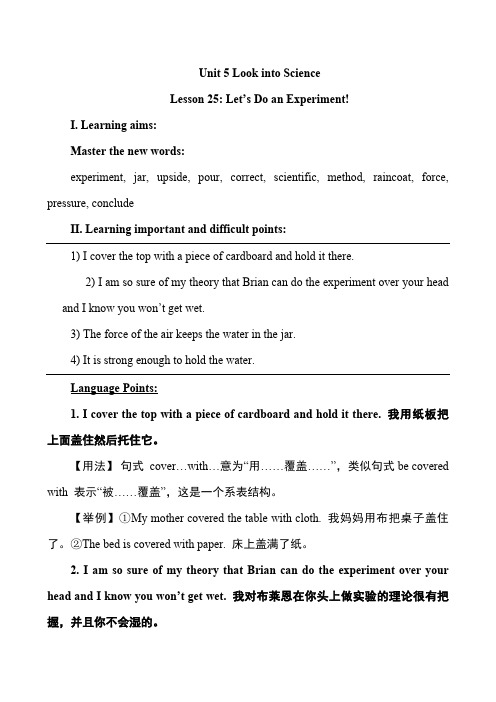
Unit 5 Look into ScienceLesson 25: Let’s Do an Experiment!I. Learning aims:Master the new words:experiment, jar, upside, pour, correct, scientific, method, raincoat, force, pressure, concludeII. Learning important and difficult points:1) I cover the top with a piece of cardboard and hold it there.2) I am so sure of my theory that Brian can do the experiment over your headand I know you won’t get wet.3) The force of the air keeps the water in the jar.4) It is strong enough to hold the water.Language Points:1. I cover the top with a piece of cardboard and hold it there. 我用纸板把上面盖住然后托住它。
【用法】句式cover…with…意为“用……覆盖……”,类似句式be covered with 表示“被……覆盖”,这是一个系表结构。
【举例】①My mother covered the table with cloth. 我妈妈用布把桌子盖住了。
②The bed is covered with paper. 床上盖满了纸。
2. I am so sure of my theory that Brian can do the experiment over your head and I know you won’t get wet. 我对布莱恩在你头上做实验的理论很有把握,并且你不会湿的。
外研版英语九年级下册Module 5 Unit 2教案与反思
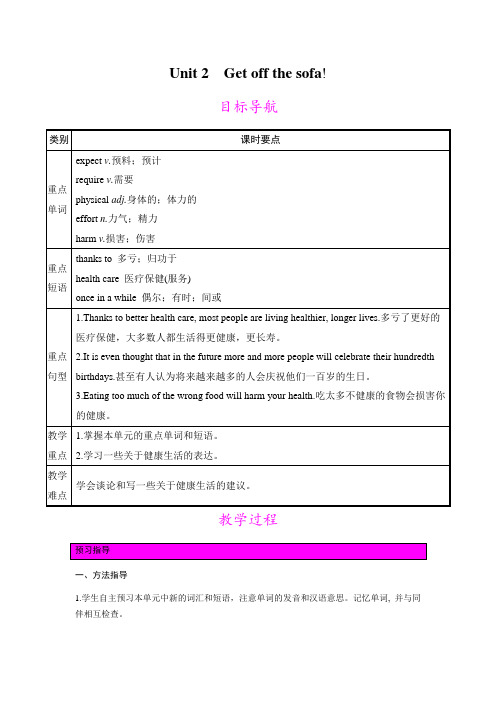
Unit 2Get off the sofa!目标导航教学过程一、方法指导1.学生自主预习本单元中新的词汇和短语,注意单词的发音和汉语意思。
记忆单词, 并与同伴相互检查。
2.了解课文主题, 搜集相关资料, 预习课文。
二、预习检测Ⅰ.根据首字母及汉语提示补全单词1.She will be here sooner than you expected(预计).2.Learning a language requires(需要)time and effort.3.Playing basketball is one kind of physical(身体的) exercise.4.We believed that he would never harm(伤害) us.5.We’ve put a great deal of time and effort(力气) into this project.Ⅱ.用方框中所给短语的适当形式填空1.The boy wants to become a doctor in the future.2.Thanks to our hard work, we can fulfil the task on time.3.If you must go,at least wait till the rain stops.4.More and more people are giving up smoking now.5.Why are you wearing two watches at the same time?Step1情景导入1. Look at the pictures in Activity 1 and talk about what the pictures tell you.2. Teacher shows the new words and expressions, and let the students to read as quickly as possible.Step2阅读1.快速阅读课文, 将文中的五项健康规则与Activity 1中的图片匹配。
英语人教版九年级全册unit5SectionB2b
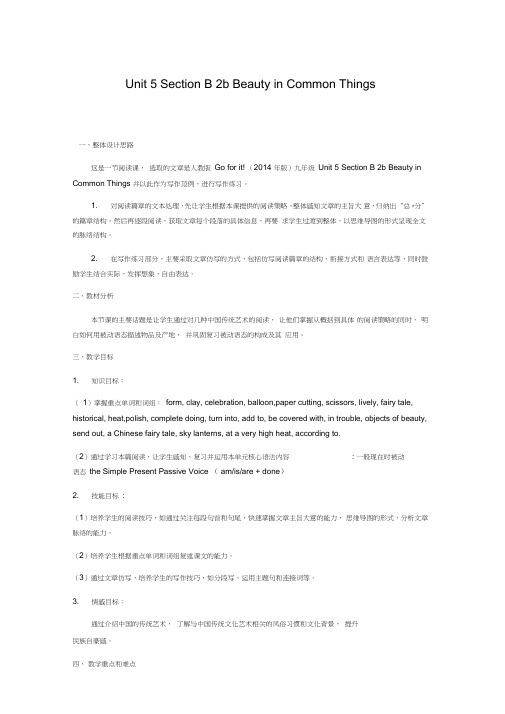
Unit 5 Section B 2b Beauty in Common Things一、整体设计思路这是一节阅读课,选取的文章是人教版Go for it! (2014 年版)九年级Unit 5 Section B 2b Beauty in Common Things 并以此作为写作范例,进行写作练习。
1. 对阅读篇章的文本处理,先让学生根据本课提供的阅读策略,整体感知文章的主旨大意,归纳出“总-分”的篇章结构。
然后再逐段阅读,获取文章每个段落的具体信息,再要求学生过渡到整体,以思维导图的形式呈现全文的脉络结构。
2. 在写作练习部分,主要采取文章仿写的方式,包括仿写阅读篇章的结构、衔接方式和语言表达等,同时鼓励学生结合实际,发挥想象,自由表达。
二、教材分析本节课的主要话题是让学生通过对几种中国传统艺术的阅读,让他们掌握从概括到具体的阅读策略的同时,明白如何用被动语态描述物品及产地,并巩固复习被动语态的构成及其应用。
三、教学目标1. 知识目标:(1)掌握重点单词和词组:form, clay, celebration, balloon,paper cutting, scissors, lively, fairy tale, historical, heat,polish, complete doing, turn into, add to, be covered with, in trouble, objects of beauty, send out, a Chinese fairy tale, sky lanterns, at a very high heat, according to.(2)通过学习本篇阅读,让学生感知、复习并运用本单元核心语法内容: 一般现在时被动语态the Simple Present Passive Voice ( am/is/are + done)2. 技能目标:(1)培养学生的阅读技巧,如通过关注每段句首和句尾,快速掌握文章主旨大意的能力,思维导图的形式,分析文章脉络的能力。
仁爱版九年级物理下unit5教案
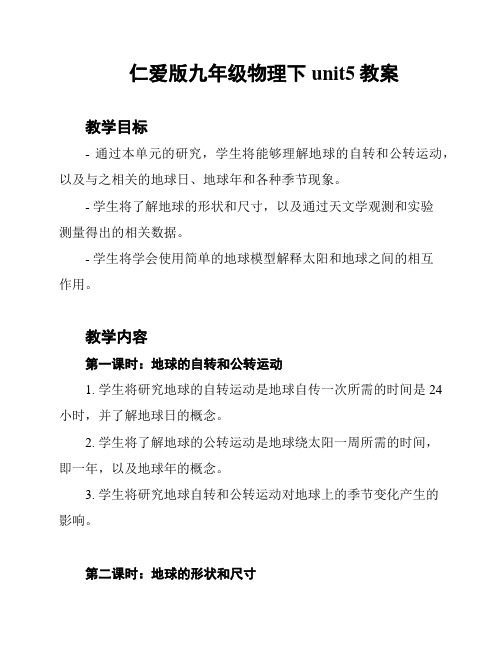
仁爱版九年级物理下unit5教案教学目标- 通过本单元的研究,学生将能够理解地球的自转和公转运动,以及与之相关的地球日、地球年和各种季节现象。
- 学生将了解地球的形状和尺寸,以及通过天文学观测和实验测量得出的相关数据。
- 学生将学会使用简单的地球模型解释太阳和地球之间的相互作用。
教学内容第一课时:地球的自转和公转运动1. 学生将研究地球的自转运动是地球自传一次所需的时间是24小时,并了解地球日的概念。
2. 学生将了解地球的公转运动是地球绕太阳一周所需的时间,即一年,以及地球年的概念。
3. 学生将研究地球自转和公转运动对地球上的季节变化产生的影响。
第二课时:地球的形状和尺寸1. 学生将了解地球的形状是近似于一个扁球体,并了解地球的直径、赤道半径和极半径的概念。
2. 学生将学会使用实验测量和天文学观测得出的数据来说明地球的形状和尺寸。
第三课时:太阳和地球的相互作用1. 学生将研究太阳和地球之间的相互作用,包括太阳光的辐射和地球大气层的吸收、反射和折射等。
2. 学生将学会使用简单的地球模型解释太阳光的直射和散射对地球各个地区温度的影响。
教学过程第一课时:地球的自转和公转运动1. 教师通过投影或板书展示地球的自转运动和公转运动的示意图,并解释相关概念。
2. 学生在教师指导下回答相关问题,并进行小组讨论,促进学生对地球自转和公转运动的理解。
3. 教师组织学生进行实验,观察地球自转运动对影子的变化和地球公转运动对季节变化的影响。
4. 学生总结本课时研究内容,并完成相关练。
第二课时:地球的形状和尺寸1. 教师通过投影或板书展示地球的形状和尺寸的示意图,并解释相关概念。
2. 学生在教师指导下观察地球模型,并测量直径、赤道半径和极半径。
3. 学生将测得的数据进行分析和讨论,并与实际观测或实验测量的数据进行比较。
4. 学生总结本课时研究内容,并完成相关练。
第三课时:太阳和地球的相互作用1. 教师通过投影或板书展示太阳和地球的相互作用的示意图,并解释相关概念。
- 1、下载文档前请自行甄别文档内容的完整性,平台不提供额外的编辑、内容补充、找答案等附加服务。
- 2、"仅部分预览"的文档,不可在线预览部分如存在完整性等问题,可反馈申请退款(可完整预览的文档不适用该条件!)。
- 3、如文档侵犯您的权益,请联系客服反馈,我们会尽快为您处理(人工客服工作时间:9:00-18:30)。
九年级下册Unit 5教案2Section B needs 1~2 periods. Section B需用1~2课时。
The main activities are 1a and 2a.本课重点活动是1a和2a。
Ⅰ. Aims and demands目标要求1. Master some new words and phrases:have fun, above, come true, so … that …, not only … but also …2. Go on learning attributive clauses which use“that”and“which”.(1)Could you tell me something about the places that you visited there?(2)That’s the most fantastic place that I have ever heard of.3. Learn more about the geography of China—the Qinghai-Tibet Plateau and WestLake.4. Cultivate the students’ patriotism.Ⅱ. Teaching aids教具录音机/幻灯片/青藏高原图片/打印材料/小黑板Ⅲ. Five-finger Teaching Plan五指教学方案Step 1 Review第一步复习(时间:10分钟)检查作业,然后用师生课前准备的旅行照片谈论他们去过的景点,复习旅行的话题。
1. (检查作业。
)T: Last class I asked you to make a dialog about travelling. Who can act it out to us with your partner?S1: ...S2: …2. (教师出示自己的旅行照片与学生交流。
)T: It’s a beautiful picture. Can you find me in it?Ss: Y es.T: You can ask me some questions according to the picture.S3: W here did you go?T: I went to Mount Tai that lies in Shandong Province.S4: When did you go there?T: Last summer holiday.S5: Did you have a good time and what did you see?T: Yes. I saw sunrise. It made me surprised and excited. The scenery there is fantastic. Mount Tai is well worth visiting. That’s the most beautiful mountain that I have ever been to. I wish you to go there some day.Ss: OK. I will.3. (学生与同伴交流他们去过或喜欢的景点,教师给出一些单词和词组。
)T: You and your partner can talk about your pictures. I’ll give you some words and phrases.(用小黑板或幻灯片展示。
)lie in, wonderful, famous, fantastic, scenery, surprised, excited, be well worth visiting, have a lot of fun, some day...(选几名学生介绍,介绍完后,其他学生可以自由提问,最后选出他们最想去的地方。
)4. (1)(呈现青藏高原图片,并教授此词。
)T: Can you guess what place it is?Ss: 青藏高原。
T: Yes. In English it’s the Qinghai-Tibet Plateau.(板书并领读。
)(2)(教师可以针对青藏高原进行简单的问答,为下一步呈现扫清障碍。
)T: Where is the Qinghai-Tibet Plateau?S6:It’s in the west of China.S7:It’s in the north of China.T: It’s in the southwest of China. It’s a fantastic place. It’s more than 4, 000 meters above sea level. The weather there changes a lot. You can experience four seasons in a day. Do you want to know more about it?Ss: Yes.T: OK. Let’s learn 1a.Step 2 Presentation第二步呈现(时间:10分钟)呈现1a。
1. (以听力的形式呈现1a。
)T: Listen to the tape and mark True (T) or False (F).(幻灯片/小黑板/打印材料出示问题,边听边判断。
)(1)The Greens went to Tibet last summer.(2)They didn’t enjoy themselves there.(3)They visited Jokhang Temple and Potala Palace.(4)The weather there never changes.(5)Susanna looks forward to visiting there as soon as possible.T: Listen again and check the answers.2. (Pair work. 读对话,找出关键词。
)(1)T: Read the dialog with your partner and find out the key words and phrases.(2)(找几组学生到黑板上写出他们找到的关键词。
)(3)①(教师用幻灯片/图表的形式出示由关键词组成的对话图解。
)(教师可以在学生找出的关键词中解释be worth doing和seem的用法。
板书) be worth doing sth. 值得做……;做……是值得的be well worth doing 很值得做……Harry Potter is well worth reading.This idea is worth considering.It seems/seemed that …似乎……seem+adj./to do sth. 好像,似乎,看来You seem happy.They seem to know me.It seems that they know what they’re doing...②(教师解释只能用that引导的定语从句。
)(板书)That’s the most fantastic place that I have everheard of.Step 3 Consolidation 第三步巩固(时间:7分钟)复述1a完成1b。
1. (利用Step 2中找出的关键词,不看课本复述对话,给学生大约3分钟的时间自己组织语言。
)T: Let’s retell the dialog according to the key words and phrases on the screen.2. (展示复述的结果,选择优、中、差三个学生作示范。
)T: Who can retell the dialog?S1: … (中)S2: … (差)S3: … (优)3. (为调动多数学生参与对课文的复述,进行Pair work,一个说,另一个听,再反之。
)T: Retell the dialog in turn with your partner.4. (完成1b。
)T: Let’s finish 1b. Fill in the blanks according to the dialog.Step 4 Practice 第四步练习(时间:12分钟)训练学生的阅读能力,完成2a和2b。
1. (直接进行2a的学习。
)T: Do you know West Lake?Ss: Yes, I do.T: What do you know about it?S1: I know the story about West Lake.S2: I know the poem about West Lake.(可以让学生用汉语来表述关于西湖的故事及诗句。
)S3: I know it’s beautiful.T: Do you know where is West Lake?S4: It lies in Hangzhou.T: What’s West Lake famous for?2. (让学生带着问题读短文。
)T: Read the passage and find out what West Lake is famous for.(2分钟后)S5: West Lake is famous for its beautiful scenery and some poems.3. (Group work, 读短文,找出难以理解的短语或句子。
小组讨论,尝试解决这些问题。
)T: Work in groups of four. Read the passage again and find out the phrases and sentences that you can’t understand. Discuss and try to understand them.(对本环节的处理,教师要本着这样的原则: 学生能自己解决的问题由学生自己来解决,学生不能解决的再提供必要的帮助。
)(教师要指出第一段中的定语从句,有必要让学生来翻译,并指出which可替换为that。
)T: Have you ever heard of the love story which is about Xu Xian and White Snake? (学生可能会有难以解决的问题。
